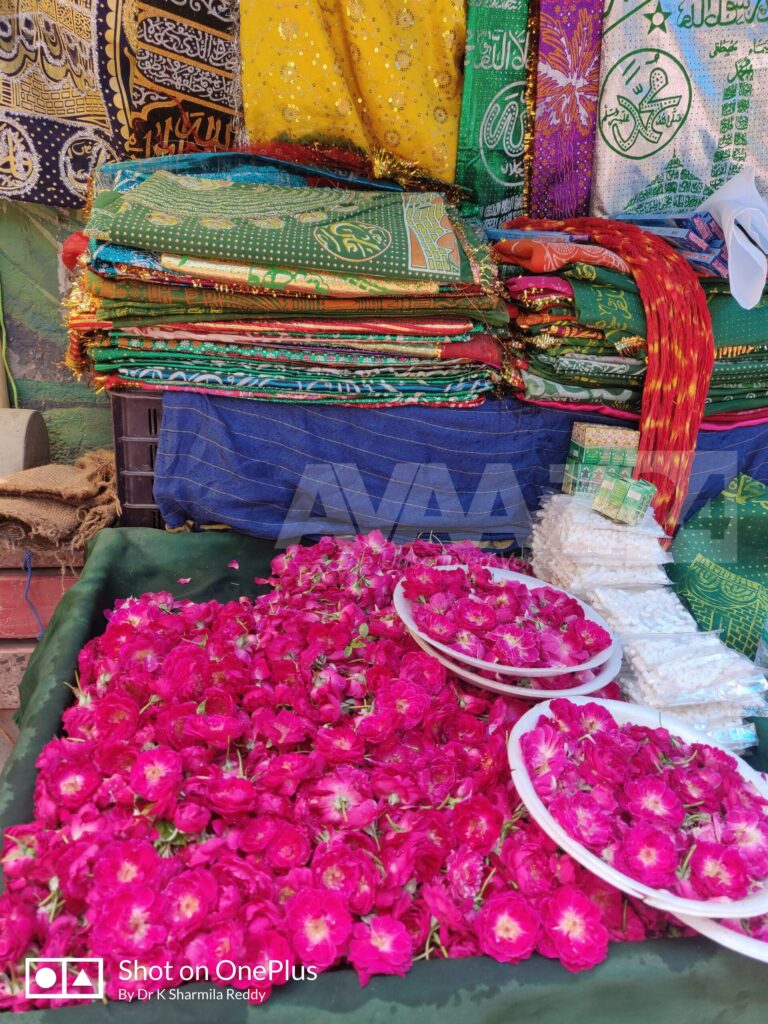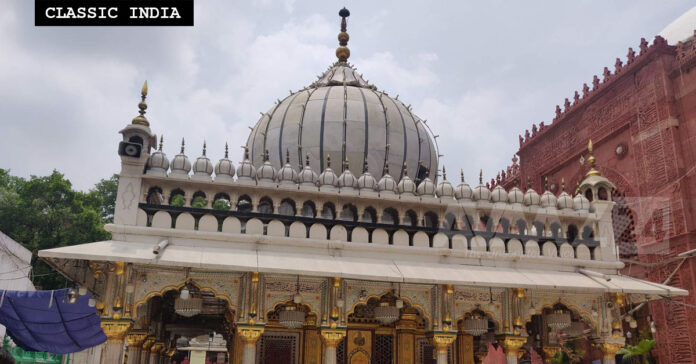Hazrat Nizam-ud-din the nucleus of India’s Sufi Culture is the Dargah of Shiek Nizam-ud-din Auliya built in Muhammad bin Tughlaq’s Jahanpanah.

Chishti Order of Sufism
This Sunni Sufi order began in Chisht, near Herat, Afghanistan. Khwaja Muin-ud-din Chishti of Ajmer founded this line in India.
The second one was Khwaja Qutb-ud-din Bakhtiyar Kaki of Mehrauli. On his name Qutb Minar, built by Qutb-ud-din Ibak exists today. He was followed by Sheik Farid-ud-din Masud Shakar Ganj of Pak Patan [present day Pakistan].

Sheik Nizam-ud-din Auliya, the fourth in the line, was the disciple of Sheik Farid-ud-din.
Sheik Nizam-ud-din Auliya: Life Story
To begin with, Nizam-ud-din’s real name was Muhammad. He was born to Sayyid Ahmad and Bibi Zulaikha at Badaun [UP] in the month of Safar (October 9) 634 AH (1236 AD). At the age of five, he lost his father. From that point, his mother took care of his up-bringing.
He came to Delhi at the age of 25 [in the time of Sultan Balban] and settled at Ghiyaspur village. He became a disciple of Baba Farid Shakarganj. Baba Farid bestowed the gift of divination to Nizam-ud-din. Later, he appointed him as his successor.
![Sheik Nizam-ud-din Auliya [from Rare Book Society of India- Hyderabad Circa 1800]](https://avaaz24.com/wp-content/uploads/2021/09/3-835x1024.jpg)
Nizam-ud-din had the wisdom of a politician. His knowledge of human nature was not from the study of books. It was because of his experiences of human life.
While living he drew the pious allegiance of eager multitudes. Even today long after his death , pilgrimages are made to his tomb from all parts of India. Miracles still work here for the believing.

Some of his Miracles:
- He declared to his disciples the exact time of the death of Jalal-ud-din Firoz Shah Khalji. Suprisingly, the same happened in Manikpur.
- In 703 AH [1303 AD] when the Moghals under Tarma Shirin invaded the territories of Ala-ud-din Khalji, the prayers of Nizam-ud-din dispersed them.
- His altercation with Ghiyas-ud-din Tughlaq, lead to the downfall of Tughlaqabad. [Read about it here.]
![Hazrat Nizam-ud-din Dargah Complex [pic from Humayun's Tomb & Adjacent Monuments- S.A.A Naqvi- 2002]](https://avaaz24.com/wp-content/uploads/2021/09/5.jpg)
- He had prophesied that Ghiyas-ud-din would never see Delhi again. The divination became true. Ghiyas-ud-din died at Afghanpur before reaching Delhi.
Know more about his death at Darul Aman- the tomb of Ghiyas-ud-din Tughlaq.
Components of Hazrat Nizam-ud-din Dargah Complex:
- Chausat Khambah
- Chashma Dil Kusha [Tomb of Bai Kokaldai & Chini Ka Burj Mosque]
- Tomb of Nizam-ud-din
- Jamat Khana Mosque
- Jahanara Begum’s Tomb [Daughter of Shah Jahan]
- Muhammad Shah Rangila’s Tomb
- Mirza Jahangir’s Tomb [son of Akbar II]
- Amir Khusrau’s Tomb
- Other Tombs
![Site Plan of Hazrat Nizam-ud-din Dargah Complex [Pic from Delhi Past & Present- H.C. Fanshawe 1902]](https://avaaz24.com/wp-content/uploads/2021/09/6-634x1024.jpg)
Chausath Khamba:
Chausath means sixty four. It is a sixty four pillared Hall, built by Mirza Aziz Kokaltash in his lifetime for his tomb. He was the foster brother of Akbar- son of Akbar’s foster mother- Ji Ji Anga.


The 64 pillars are supported with 25 bays. Each bay supports a dome.

The domes are not visible externally since they are reverse domes. Thus, the roof is flat.


2. Chashma Dil Kusha- Baoli of Nizam-ud-din
At the northern gate of the enclosure of the Dargah is a large baoli called “Chashma dil Kusha” [Heart Alluring Spring]. It was commissioned by Nizam-ud-din himself in 1321.

The Baoli measures 123’ x 53’ internally. Towards, the north it has descending steps. It has walls on the remaining three sides i.e. South, East and West.

Nizam-ud-din Baoli- the Contention between Nizam-ud-din and Ghiyas-ud-din Tughlaq
Nizam-ud-din started building his well at the same time, when Ghiyas-ud-din started his Tughlaqabad.
Ghiyas-ud-din was anxious for completion of his city. Hence, he prohibited people from working on the Baoli. He compelled everyone to work only at Tughlaqabad. Then, the workmen worked for the saint at night.
Knowing this, Ghiyas-ud-din there upon prohibited the sale of oil. The masons then lit their lamps with the water of the Baoli, after a blessing from the Saint.
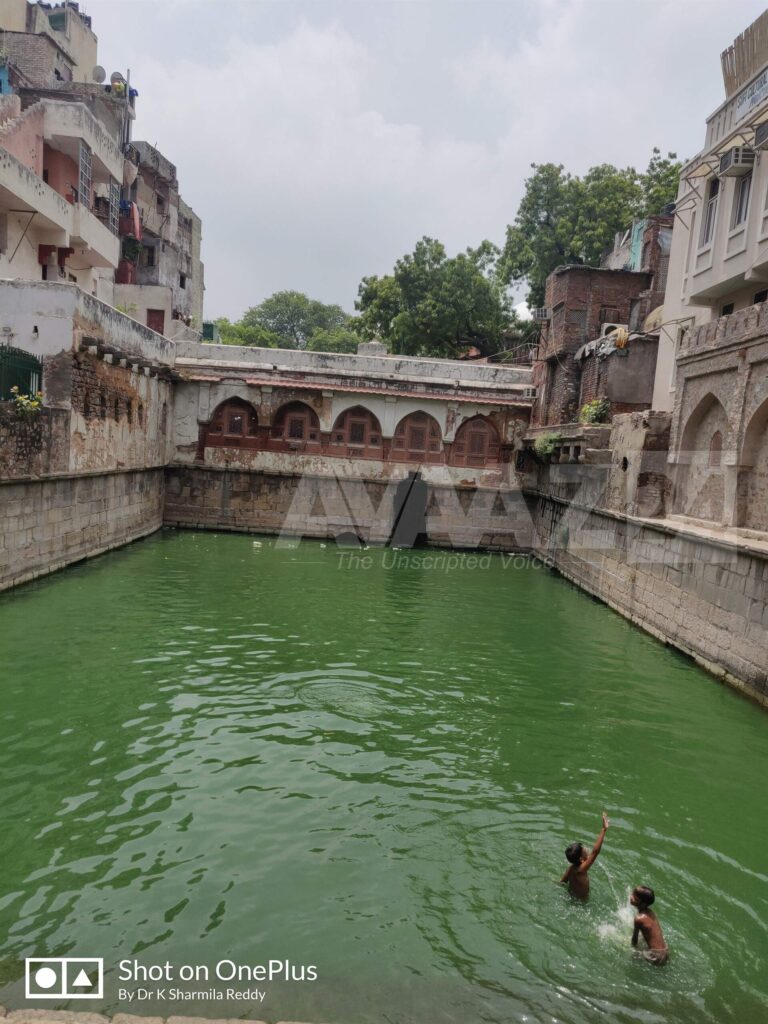
In his wrath, the emperor cursed the water of the tank and it became bitter and the saint in retaliation cursed the city of Tughlaqabad
Read more about the causes of downfall of Tughlaqabad- here
On the completion of the well the saint blessed the water. Hence the common belief- this water cures diseases and expels evil spirits.
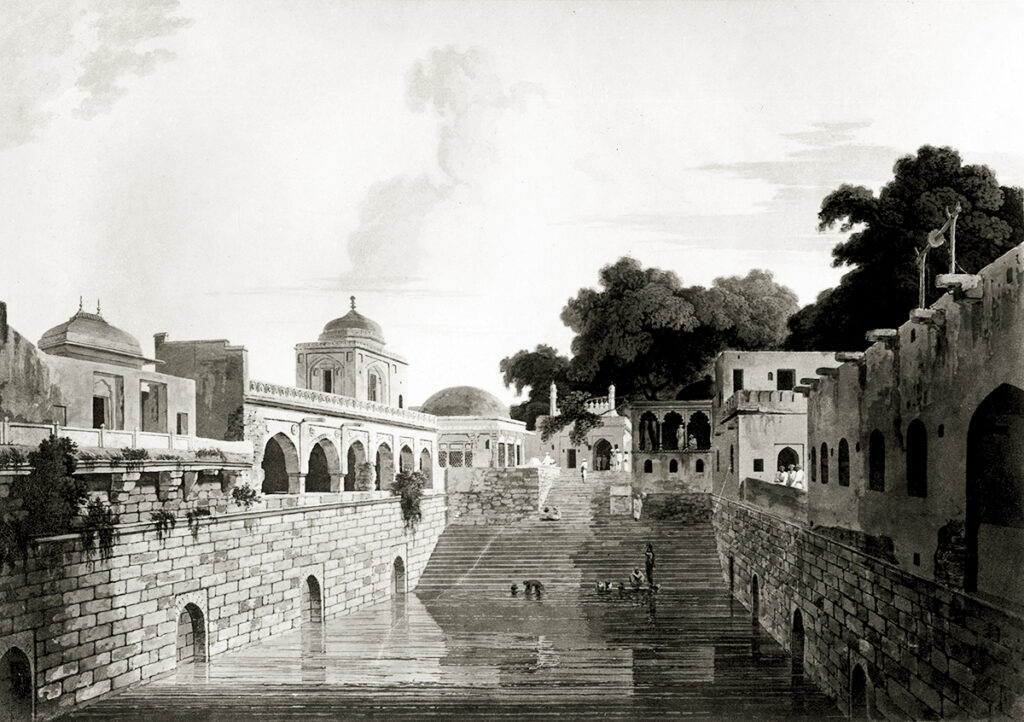
Tomb of Bai Kokaldai
On the western wall of Nizam-ud-din Baoli, this tomb of Bai Kokaldai exists. As per the inscription it belongs to Bai Kokaldai the daughter of Mulayam Khan. It is constructed in 948 AH (1541-42 AD).
No information regarding who is she is can be derived from the inscription.

H. C. Fanshawe in his book Delhi Past & Present- 1902 calls her as a prima donna of the Emperor shah Jahan [the chief female singer].
Chini Ka Burj Mosque:
On the western wall, next to Tomb of Bai Kokaldai there exists a mosque. This Chini Ka Burj mosque is of Lodi Era.

Tomb of Nizam-ud-din:
The original building of tomb of Sheik Nizam-ud-din has been extended, embellished and renovated in the course of centuries.
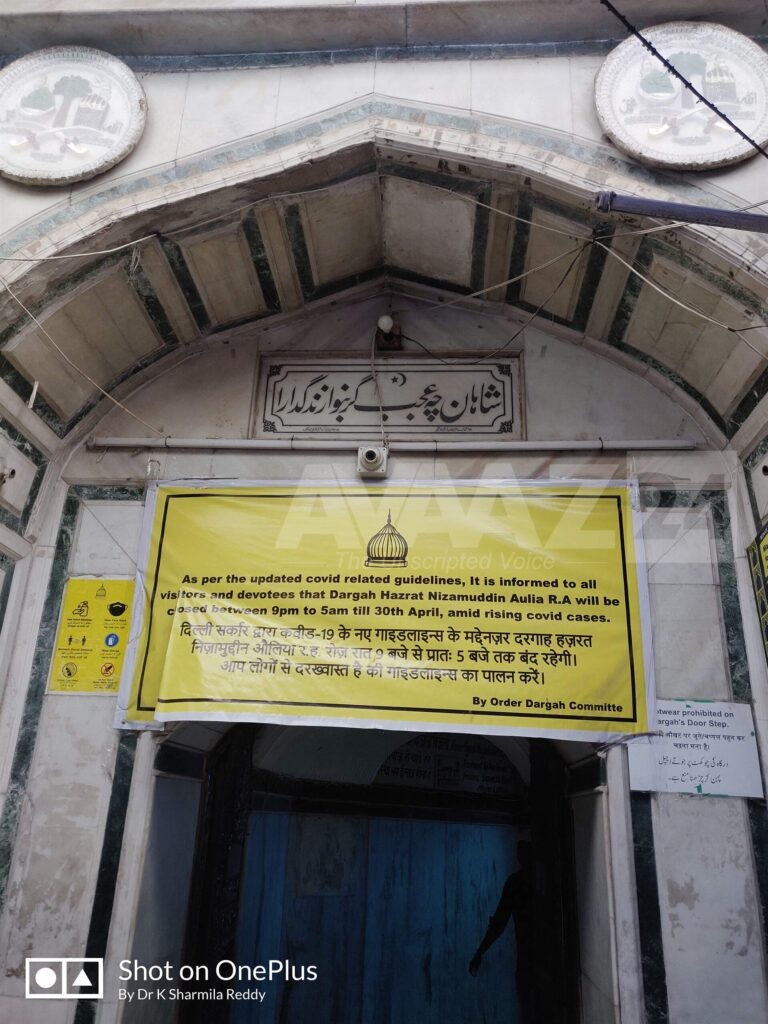
Muhammad bin Tughlaq after the saint’s death built a masonry cupola over the grave. The next ruler Feroz Shah Tughlaq, repaired and decorated it.

The present building is built by Faridun Khan in 970 AH (1562-63 AD). He was a noble from Emperor Akbar’s court.
Architecture of the Tomb:
Verandah:
It is about 30 feet square, with five arched openings on each side, supported by 20 marble pillars. A six feet wide verandah surrounds the room which contains the grave. The columns of the verandah carry trefoil arches which in turn support a red sandstone chajja.

Marble Dome:
In the year 1239 AH [1823 AD] Akbar II removed the masonry dome and replaced it with the present marble one. This white marble dome has vertical stripes of black marble and has a copper gilt pinnacle.

Pavilion of the Roof:
On the four corners of the tomb, there are dwarf marble chattris with gilt finials. The pavilion of the roof is protected by a parapet wall made of solid masonry domes.
Tomb Chamber:
The tomb chamber is of 18 feet square and has only one door on its south. The remaining three sides of the chamber has windows of red sandstone with lattice work frames. The flooring of the grave is of marble.

Grave/Cenotaph:
The Marble grave measures 8’3”x 4’4” x 1’1” (height). It bears no inscription. It is covered by a chaddar and Fragrant rose petals.
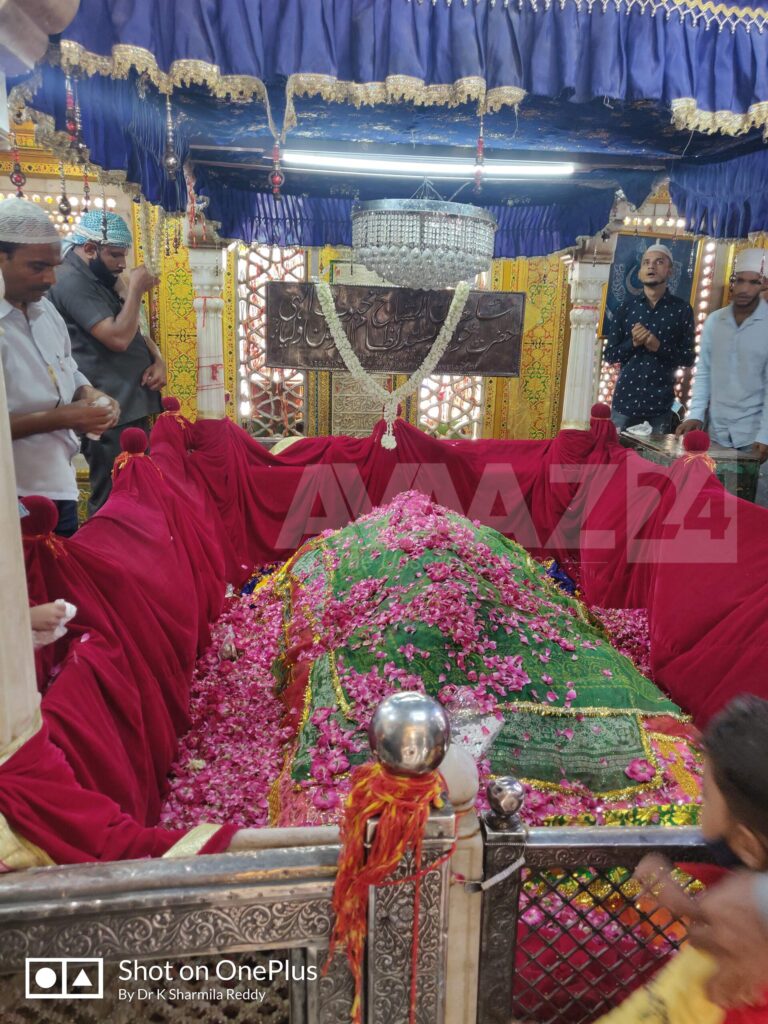
The grave has a 2 feet height wooden railing enclosure . A Holy Quran is seen on a stool, next to the grave.
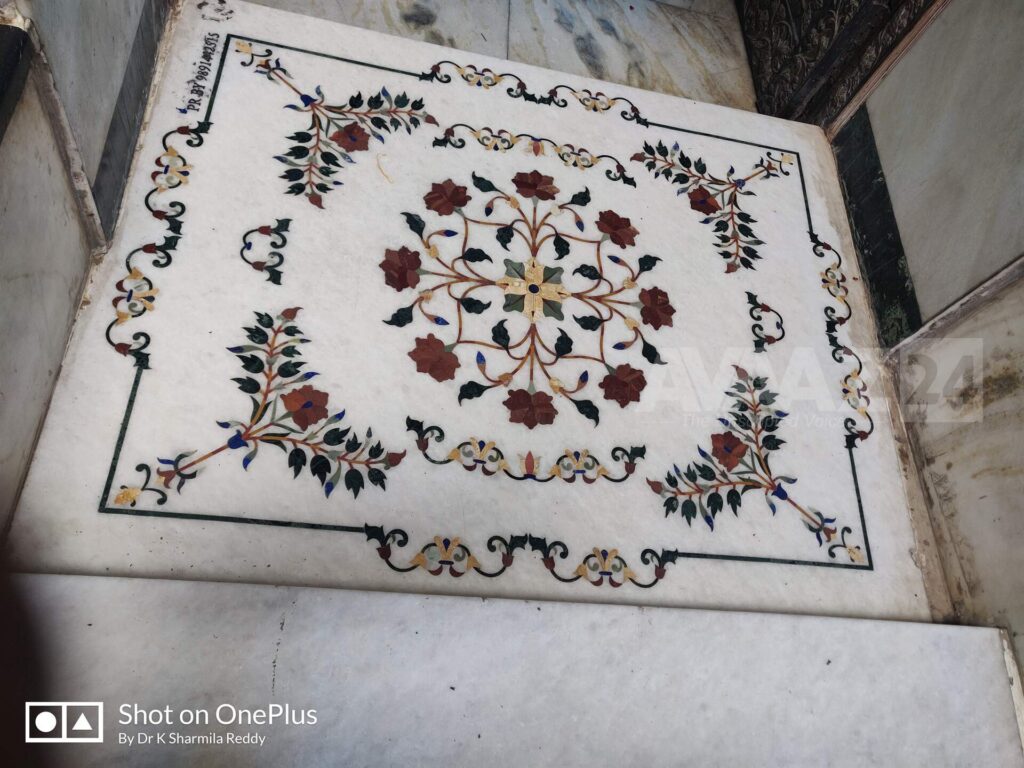
In 1882-83 Khurshid Jah of Hyderabad built a marble balustrade around the grave.
4) Jamat Khana Mosque:
This is a Pathan Style Mosque, located to the west of Nizam-ud-din’s Tomb. It is entirely according to Islamic conceptions. It is the oldest building in the entire complex.
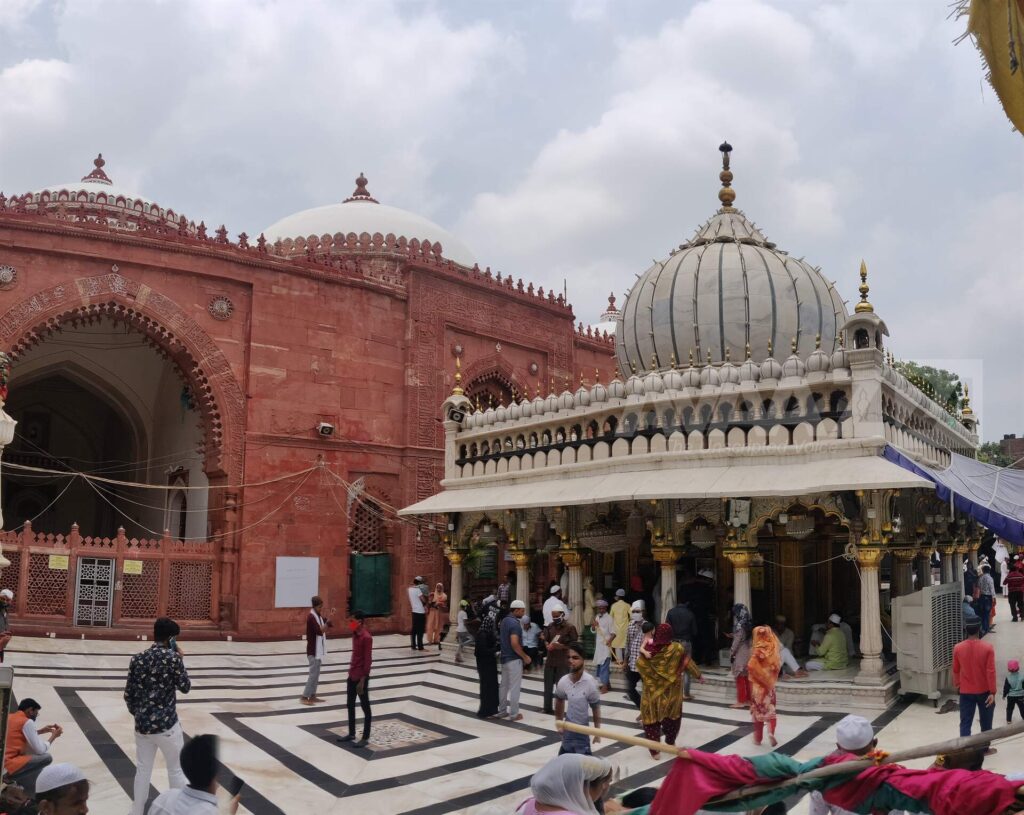
It is constructed between 1312 and 1313 by Ala-ud-din Khalji’s son Khizr Khan. Hence it is also called as Khizri Mosque.
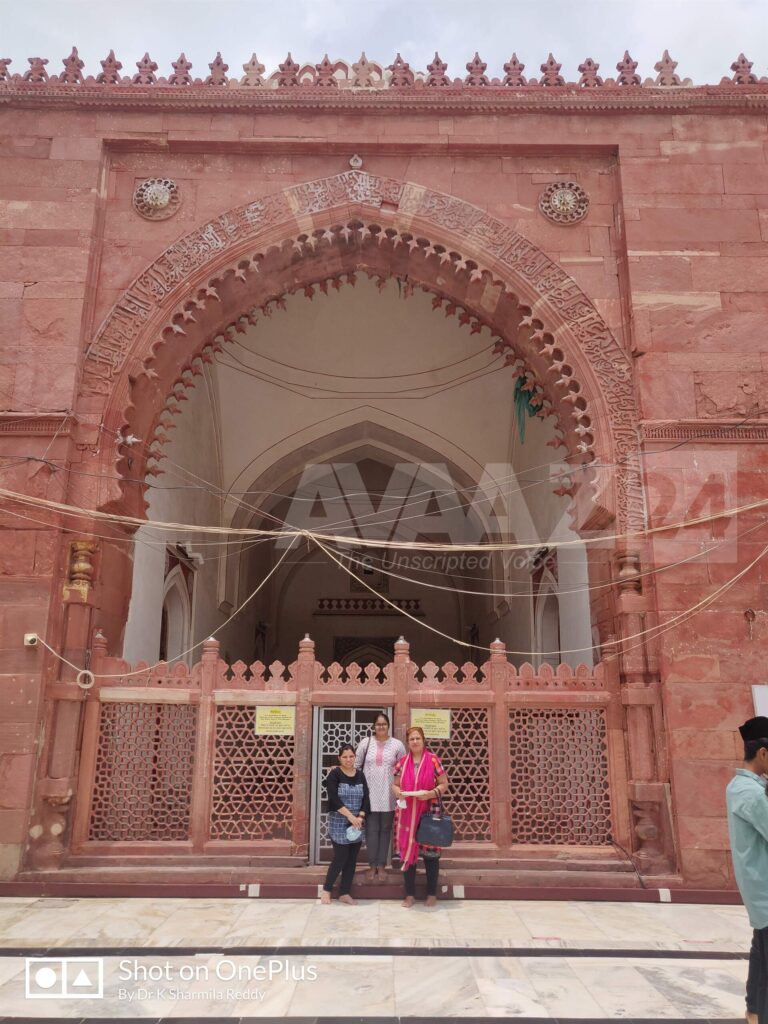
Built of red sandstone, Jamat Khana mosque has three bays. Khizr Khan built the central dome and the hall. Two adjoining halls and their respective domes are by Muhammad bin Tughlaq in 1325 AD.
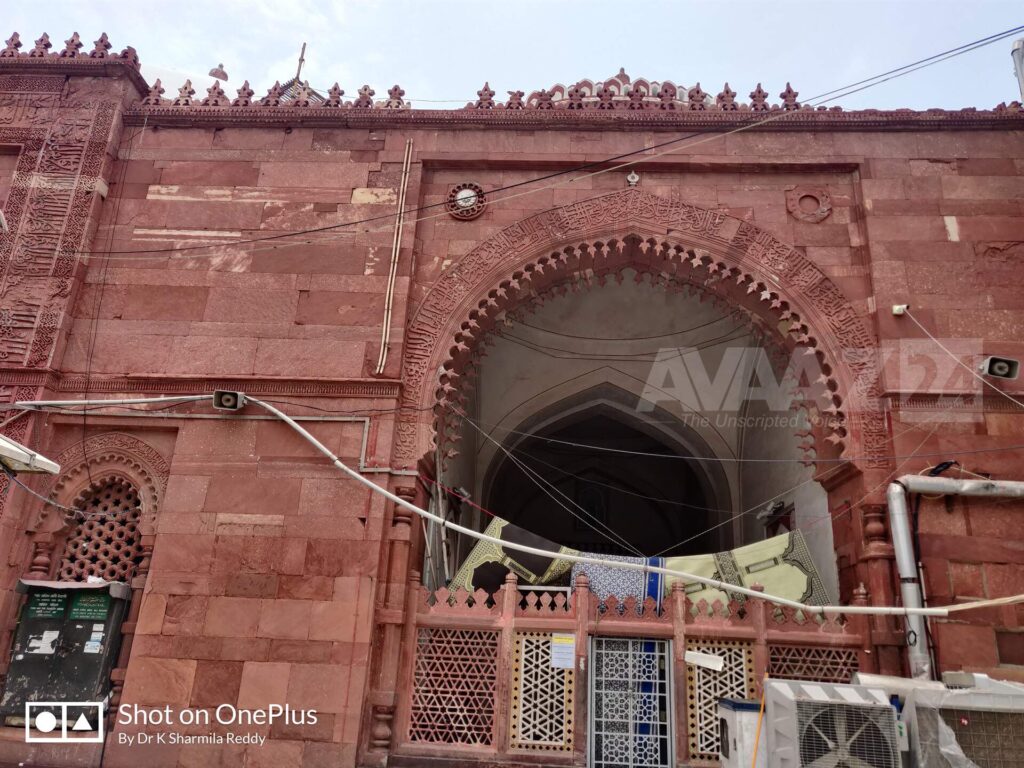
Its stone walls are beautifully carved with Quranic Ayats (verses). Its arches are fringed with the ‘lotus-bud’ decoration, similar to Ala-i-Darwaza.

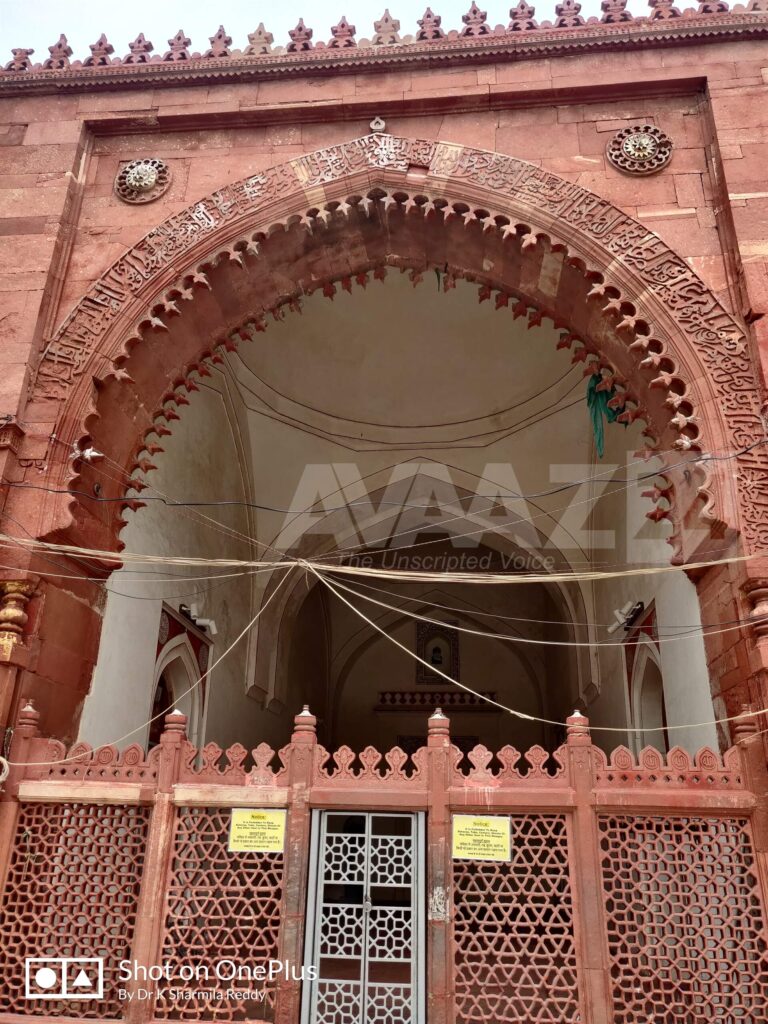
5) Jahanara Begum’s Tomb
Jahanara Begum, the daughter of Shah Jahan and Mumtaz Mahal was born on 21st of Safar 1023 AH [2 April, 1614 AD].

This Padshah Begum [First Lady] was the most powerful woman in the Mughal empire during her time.

She espoused the cause of Dara Shikoh in the struggle between two brothers (Dara & Aurangzeb). When Aurangzeb deposed and imprisoned Shah Jahan at Agra Fort, she devoted herself in taking care of her father till his death in 1666.

She was an ardent proponent of Sufism. She wrote a biography on Moin-ud-din Chishti of Ajmer- “Mu’nis al-Arwāḥ”
Upon her death on 3rd Ramzan 1092 AH [16th September 1681 AD] she was buried next to the Nizam-ud-din’s Tomb.

The marble cenotaph of Jahanara is unique. It has a central hollow.
Jahanara Begum’s Inscription:
To the north of it stands a handsome headstone with verses written by the Princess herself.
“Allah is the Living, the Sustaining.
Let no one cover my grave except with greenery,
For this very grass suffices as a tomb cover for the poor.
The mortal simplistic Princess Jahanara,
Disciple of the Khwaja Moin-ud-Din Chishti,
Daughter of Shah Jahan the Conqueror
May Allah illuminate his proof- 1092 [1681 AD]”

Let’s read more about her in the subsequent article of this Classic India Series- Chandini Chowk.
6) Muhammad Shah Rangila’s Tomb
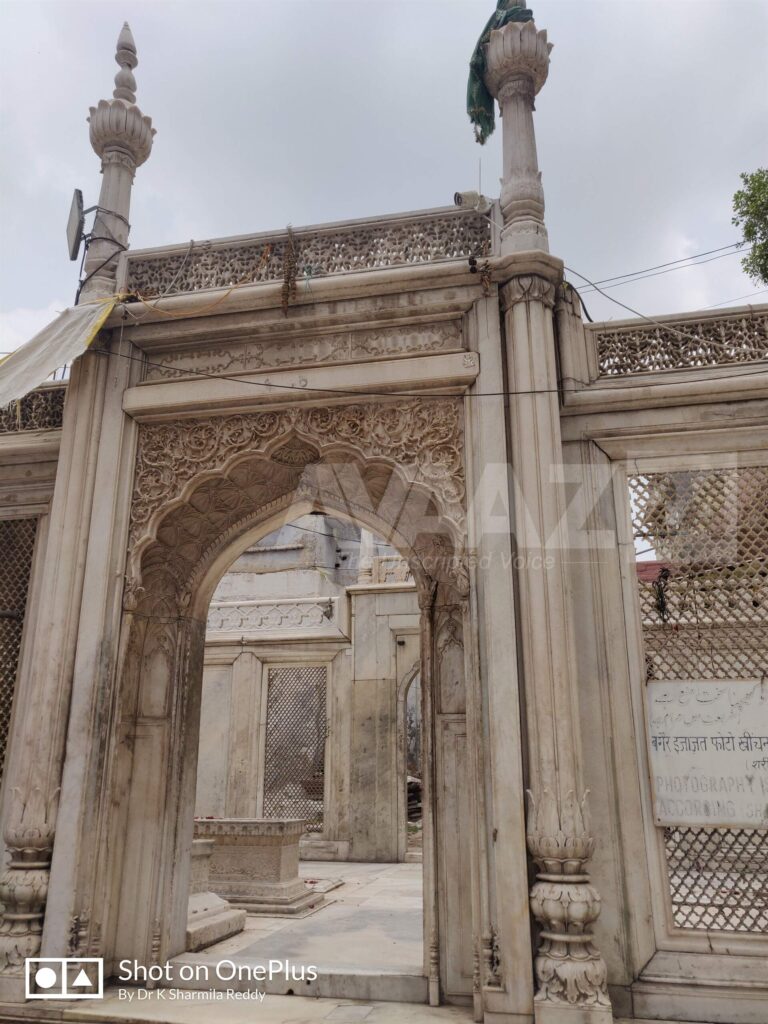
Emperor Muhammad Shah- the unhappy emperor who saw the capture of Delhi by Nadir Shah died in 1748.

7) Mirza Jahangir’s Tomb[son of Akbar II]
Prince Mirza Jahangir’s behavior after his return from Allahabad exile worsened.
To know, why he was exiled to Allahabad- read Jahaz Mahal.
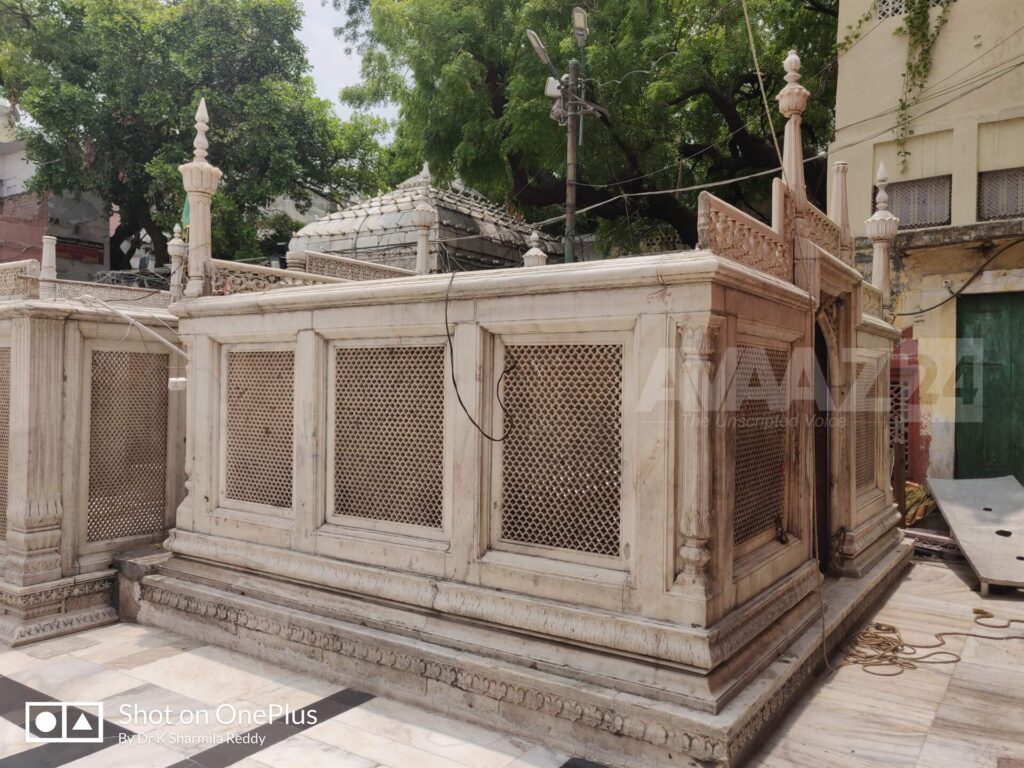
When he tried to poison his elder brother Bahadur Shah Zafar, Akbar II agreed with British and sent him back to Allahabad. He died there in 1821 AD. His body was brought back to Delhi and was interred in this Hazrat Nizam-ud-din Dargah complex.

8) Amir Khusrau’s Tomb
The famous Sufi Poet Amir Khusrau was a devoted friend and chief disciple of Nizam-ud-din Auliya. He died at an advanced age in 1325 AD soon after his master whom he refused to survive.
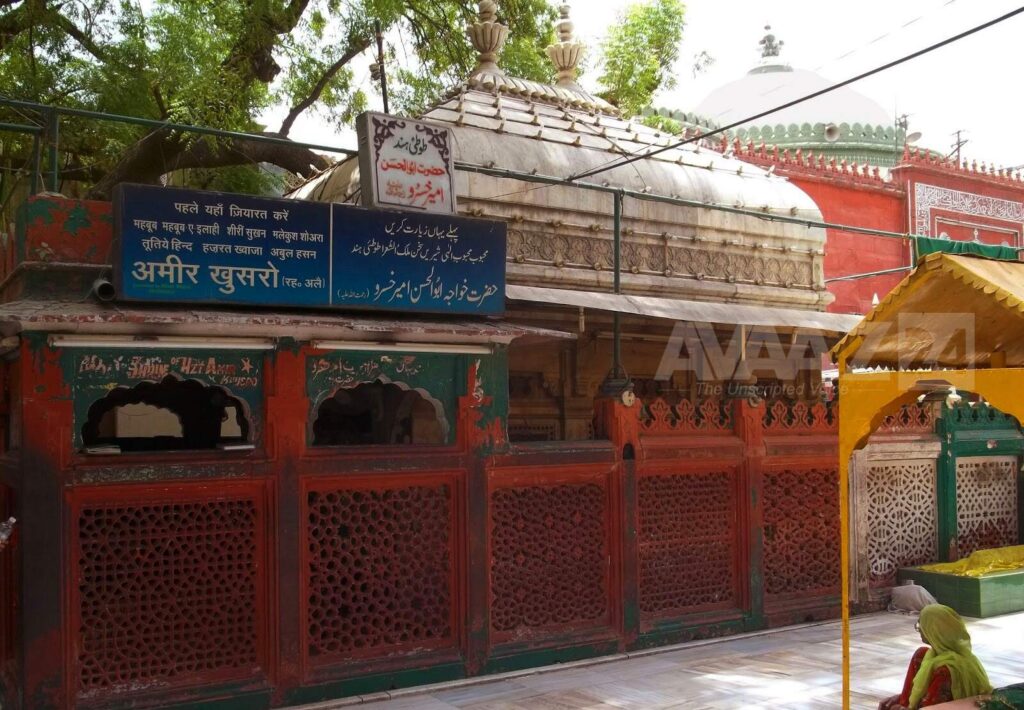
He is popularly known as “Tuti-i-shakar-makal”- Sugar tongued Parrot.
A poem by Amir Khusrau:
Every Sect has a faith, a direction (Qibla) to which they turn,
I have turned my face towards the crooked cap (of Nizamuddin Auliya)
The whole world worships something or the other,
Some look for God in Mecca, while some go to Kashi (Benares),
So why can’t I, Oh wise people, fall into my beloved’s feet?
Every sect has a faith, a Qibla

9) Other Tombs
It is considered auspicious to be buried near Nizam-ud-din’s grave. Therefore, more than 70 graves are seen here today.
Some of the notable ones are of – Ziauddin Barani [contemporary chronicler of 14th century], Mirza Babur [brother of Bahadur Shah Zafar II & Mirza Jahangir], Mirza Galib [18th century Poet] etc.
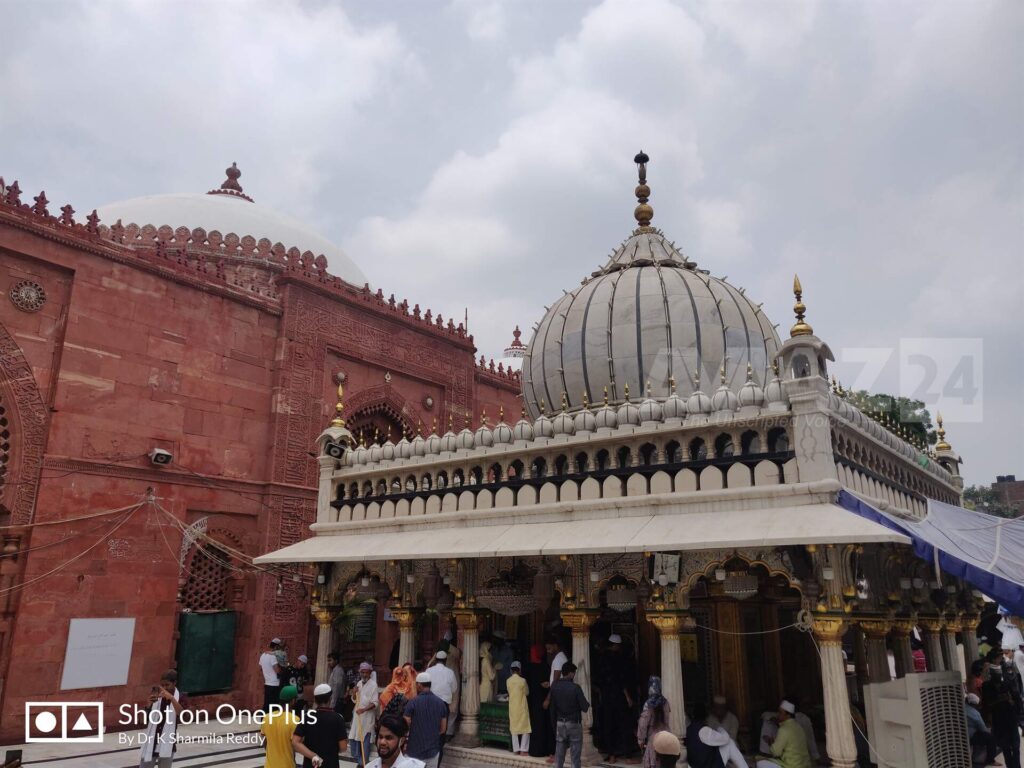
Cultural Significance of Hazrat Nizam-ud-din:
- Nizam-ud-din is considered as “Mehboob-e-Ilahi”-the guardian saint of Delhi.
- This Dargah is the nucleus of India’s Sufi Culture. The saint’s Urs is on 17th and 18th day of Islamic month of Rabi.
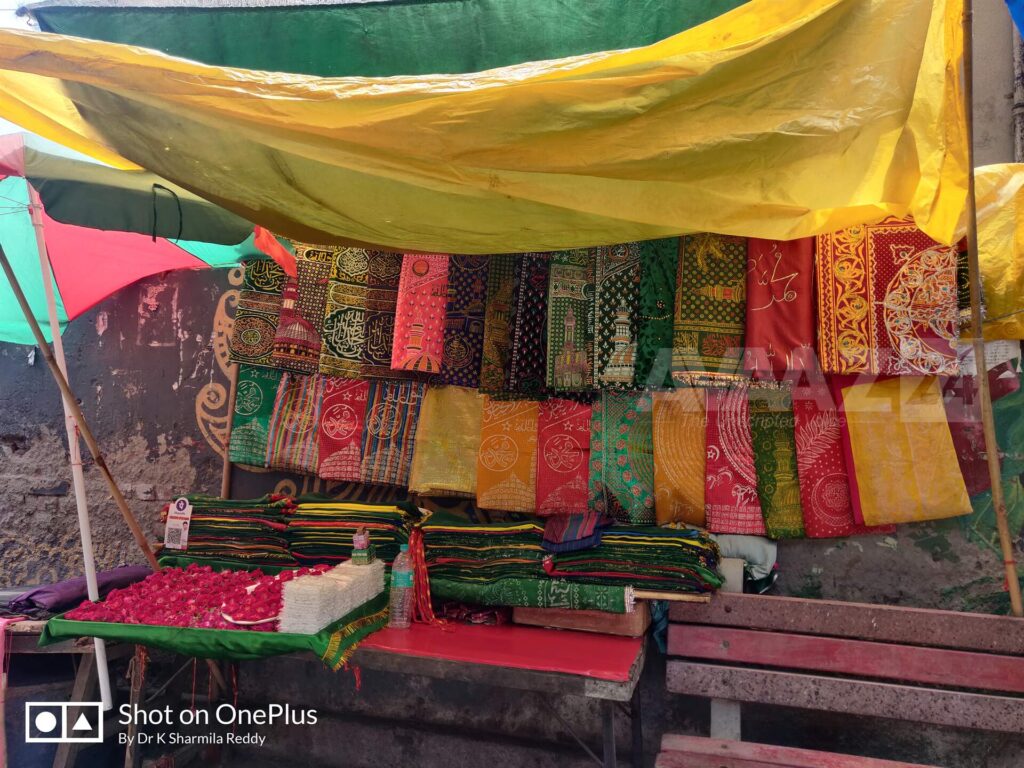
- Being a hub of cultural activities since 13th century, the Dargah attracted many buildings around it- Humayun’s Tomb, Tombs of Mirza Ghalib and Abdul Rahim Khan-i-Khana, Sabz Burj, Sunderwala Nursery etc are some among them.
- Every Thursday, a traditional Qawwali happens here. The evening prayers in which lamps are lit, is a beautiful scenery called “Dua-e-Roshni”.
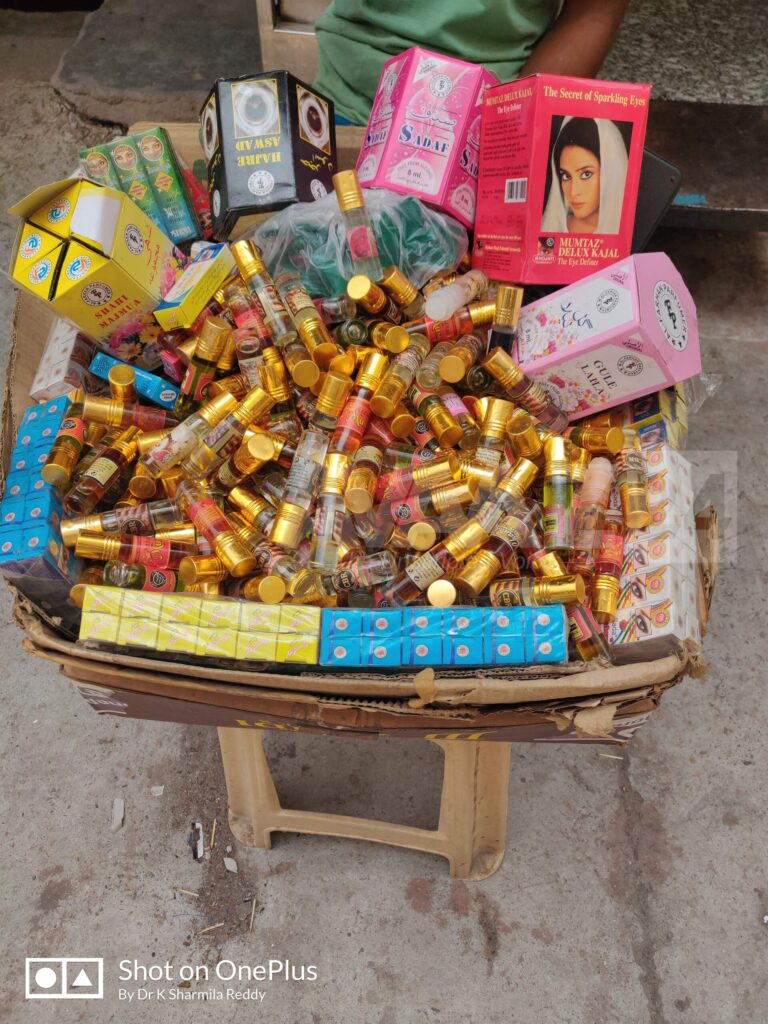
- At this Dargah, Basant Panchami festival is also celebrated. Legend says that Khusrau made Nizam-ud-din forget his grief over his nephew’s death on this day.
